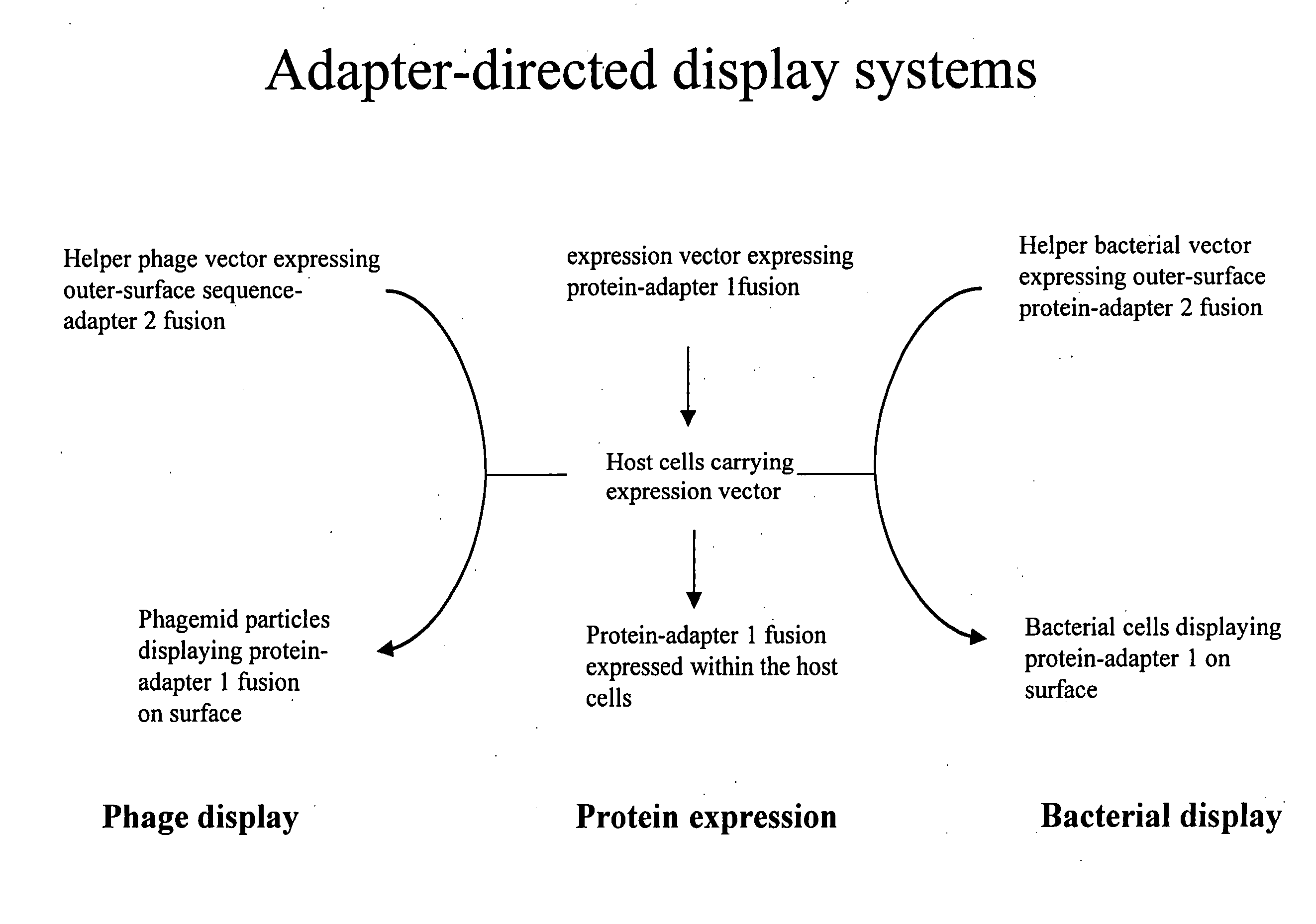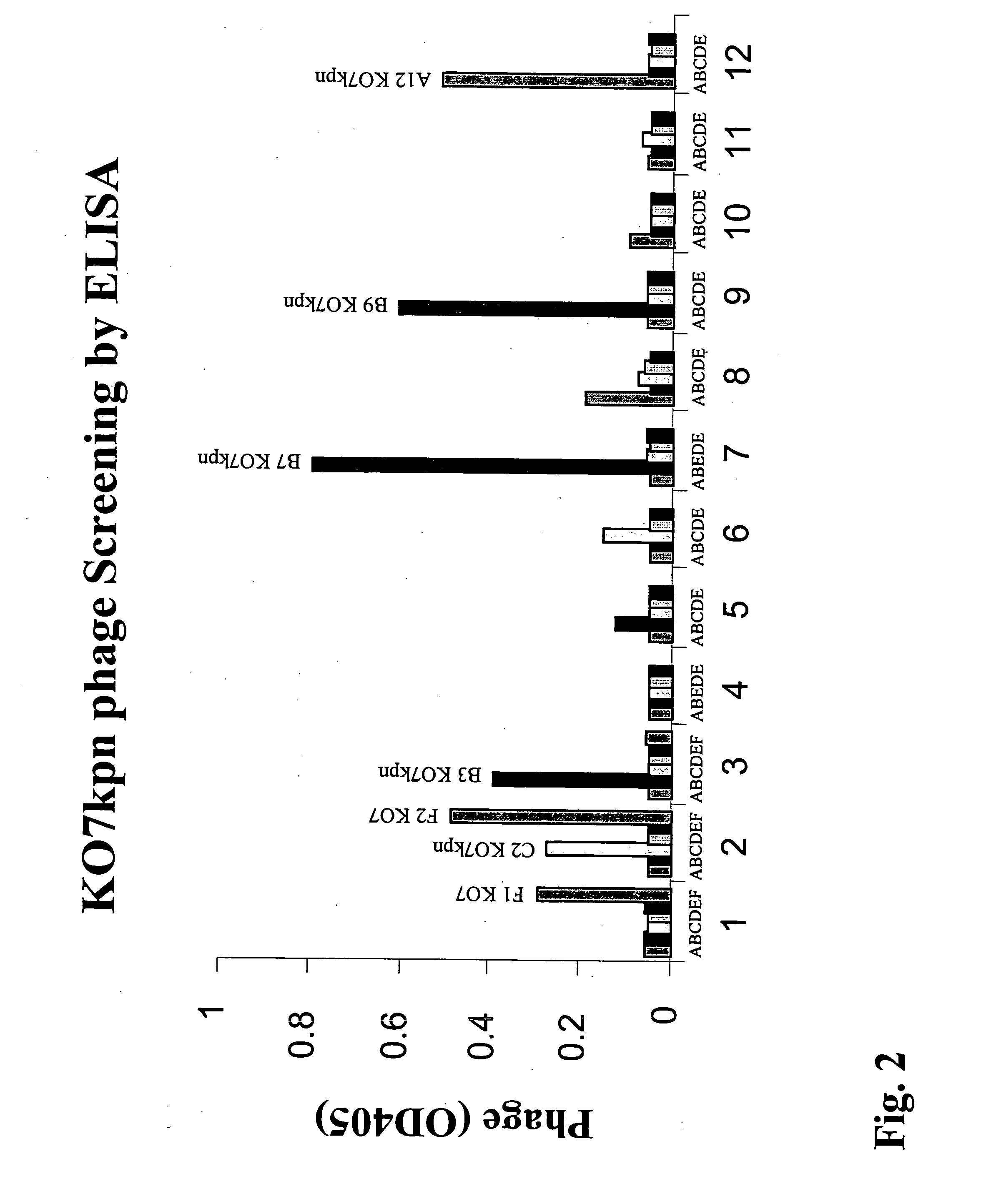Adaptor-directed helper systems
- Summary
- Abstract
- Description
- Claims
- Application Information
AI Technical Summary
Benefits of technology
Problems solved by technology
Method used
Image
Examples
example 1
Preparation and Uses of KO7kpn Helper Phage
A. Construction of KO7kpn Vector:
[0203] The KO7kpn vector was constructed by modifying a well-characterized vector, namely M13KO7 (from Amersham Pharmacia) according to the procedure detailed below. The resulting vector is identical to KO7 except that a unique KpnI restriction site has been inserted into the gene III leader sequence without disrupting the gene III coding region (see FIGS. 3A and 3B).
[0204] The KpnI site was introduced into the gene III leader sequence of KO7 helper phage vector by PCR-based site-directed mutagenesis. The KO7 genome was amplified by PCR using the following primers which contain KpnI sites: p3KN1: 5′-TTTAGTGGTACCTTTCTATTCTCACTCCGCTG-3′ and p3KN2: 5′-TAGAAAGGTACCACTAAAGGAATTGCGAATAA-3′. These primers share partial sequence homology to gene III leader sequence.
[0205] PCR was performed in a 100 ul reaction mixture containing 100 ng KO7 vector DNA, 20 pmol each of primers, 250 uM dNTP, and 1× pfu buffer and ...
example 2
Preparation of an Adapter-Directed Display System Comprising GM-UltraHelper Phage Vectors
A. Construction of GM-UltraHelper Phage Vector:
[0212] The pABMC6 vector was constructed by replacing the sequence between the XbaI and BgIII sites of vector pABMD1 (FIG. 22A) with a synthetic DNA fragment encoding a partial gene III leader sequence with a KpnI site, and coding sequences for GR2 domain (the coiled-coil domain of the human GABAB receptor 2) and Myc-tag (FIG. 4). The sequence for GR2-Myc domain was directly fused with the pIII coding sequence in pABMD1 vector, and was confirmed by DNA sequencing.
[0213] The GM-UltraHelper phage vector was constructed by replacing the KpnI / BamHI fragment encoding a partial pIII leader (amino acid residues 11-19) and partial pIII protein (amino acid residues 1-197) in the KO7Kpn helper vector with the corresponding fragment encoding a partial pIII leader and the adaptor2-pIII fusion protein from the pABMC6 vector. The resulting GM-UltraHelper phag...
example 3
Preparation of an Adapter-Directed Display System Comprising CM-UltraHelper Phage Vector
A. Construction of CM-UltraHelper Phage Vector:
[0220] The pABMC 13 vector was constructed by replacing the sequence between the XbaI and BglII sites of vector pABMD1 (FIG. 22) with a synthetic DNA fragment comprising 5′ to 3′ a gene III leader sequence, a KpnI site, a coding sequence for Ala-Cys-Gly-Gly and a Myc-tag (FIG. 12). This synthetic sequence was linked in-frame with gene III in pABMD1 vector.
[0221] The CM-UltraHelper phage vector was constructed by replacing the KpnI / BamHI fragment encoding (amino acid residues 11-19) and partial p III protein (amino acid residues 1-197) in the KO7Kpn helper vector with the corresponding fragment encoding a partial p III leader and the adaptor2-pIII fusion protein from the pABMC13 vector. The resulting CM-UltraHelper phage vector (FIG. 13A) encodes an engineered pIII capsid fused with Cys-myc domain placed at the N-terminal of pIII. (FIG. 13B). In a...
PUM
 Login to View More
Login to View More Abstract
Description
Claims
Application Information
 Login to View More
Login to View More - R&D
- Intellectual Property
- Life Sciences
- Materials
- Tech Scout
- Unparalleled Data Quality
- Higher Quality Content
- 60% Fewer Hallucinations
Browse by: Latest US Patents, China's latest patents, Technical Efficacy Thesaurus, Application Domain, Technology Topic, Popular Technical Reports.
© 2025 PatSnap. All rights reserved.Legal|Privacy policy|Modern Slavery Act Transparency Statement|Sitemap|About US| Contact US: help@patsnap.com



